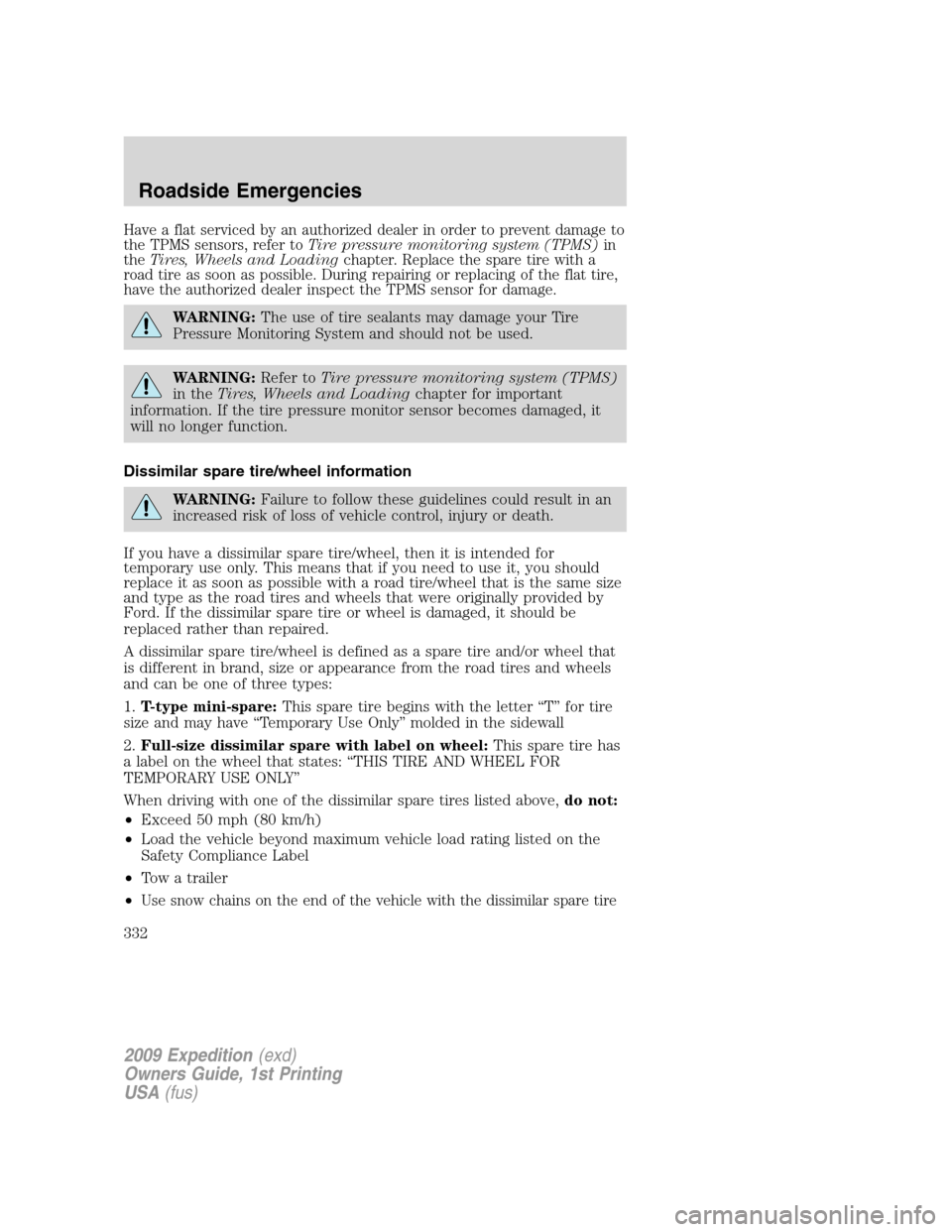Page 332 of 416

Have a flat serviced by an authorized dealer in order to prevent damage to
the TPMS sensors, refer toTire pressure monitoring system (TPMS)in
theTires, Wheels and Loadingchapter. Replace the spare tire with a
road tire as soon as possible. During repairing or replacing of the flat tire,
have the authorized dealer inspect the TPMS sensor for damage.
WARNING:The use of tire sealants may damage your Tire
Pressure Monitoring System and should not be used.
WARNING:Refer toTire pressure monitoring system (TPMS)
in theTires, Wheels and Loadingchapter for important
information. If the tire pressure monitor sensor becomes damaged, it
will no longer function.
Dissimilar spare tire/wheel information
WARNING:Failure to follow these guidelines could result in an
increased risk of loss of vehicle control, injury or death.
If you have a dissimilar spare tire/wheel, then it is intended for
temporary use only. This means that if you need to use it, you should
replace it as soon as possible with a road tire/wheel that is the same size
and type as the road tires and wheels that were originally provided by
Ford. If the dissimilar spare tire or wheel is damaged, it should be
replaced rather than repaired.
A dissimilar spare tire/wheel is defined as a spare tire and/or wheel that
is different in brand, size or appearance from the road tires and wheels
and can be one of three types:
1.T-type mini-spare:This spare tire begins with the letter “T” for tire
size and may have “Temporary Use Only” molded in the sidewall
2.Full-size dissimilar spare with label on wheel:This spare tire has
a label on the wheel that states: “THIS TIRE AND WHEEL FOR
TEMPORARY USE ONLY”
When driving with one of the dissimilar spare tires listed above,do not:
•Exceed 50 mph (80 km/h)
•Load the vehicle beyond maximum vehicle load rating listed on the
Safety Compliance Label
•Tow a trailer
•
Use snow chains on the end of the vehicle with the dissimilar spare tire
2009 Expedition(exd)
Owners Guide, 1st Printing
USA(fus)
Roadside Emergencies
332
Page 392 of 416

Driving style — good driving and fuel economy habits
Give consideration to the lists that follow and you may be able to change
a number of variables and improve your fuel economy.
Habits
•Smooth, moderate operation can yield up to 10% savings in fuel.
•Steady speeds without stopping will usually give the best fuel
economy.
•Idling for long periods of time (greater than one minute) may waste
fuel.
•Anticipate stopping; slowing down may eliminate the need to stop.
•Sudden or hard accelerations may reduce fuel economy.
•Slow down gradually.
•Driving at reasonable speeds (traveling at 55 mph [88 km/h] uses 15%
less fuel than traveling at 65 mph [105 km/h]).
•Revving the engine before turning it off may reduce fuel economy.
•Using the air conditioner or defroster may reduce fuel economy.
•You may want to turn off the speed control in hilly terrain if
unnecessary shifting between the top gears occurs. Unnecessary
shifting of this type could result in reduced fuel economy.
•Warming up a vehicle on cold mornings is not required and may
reduce fuel economy.
•Resting your foot on the brake pedal while driving may reduce fuel
economy.
•Combine errands and minimize stop-and-go driving.
Maintenance
•Keep tires properly inflated and use only recommended size.
•Operating a vehicle with the wheels out of alignment will reduce fuel
economy.
•Use recommended engine oil. Refer toMaintenance product
specifications and capacitiesin this chapter.
•Perform all regularly scheduled maintenance items. Follow the
recommended maintenance schedule and owner maintenance checks
found inscheduled maintenance information.
Conditions
•Heavily loading a vehicle or towing a trailer may reduce fuel economy
at any speed.
2009 Expedition(exd)
Owners Guide, 1st Printing
USA(fus)
Maintenance and Specifications
392
Page 415 of 416

Servicing your vehicle ..............367
Setting the clock
AM/FM single CD .....................26
AM/FM/In-dash 6 CD ................33
Snowplowing .................................8
Spark plugs,
specifications .....................400, 405
Special notice
utility-type vehicles ....................8
Specification chart,
lubricants ...................................401
Speed control ............................121
Stability system .........................293
Starting a flex fuel vehicle .......287
Starting your vehicle ........284–287
jump starting ..........................341
Steering wheel
controls ....................................124
tilting .......................................108
SYNC ............................................83
T
Tilt steering wheel ....................108
Tire Pressure Monitoring
System (TPMS)
Driving .....................................317
Tires, Wheels and Loading ....263
Warning Displays ......12, 138, 151
Tires ...........................248–249, 331
alignment ................................257
care ..........................................253
changing ..........................331, 335
checking the pressure ............253
inflating ...................................251
label .........................................262
replacing ..................................254
rotating ....................................257safety practices .......................256
sidewall information ...............258
snow tires and chains ............268
spare tire .................................332
terminology .............................250
tire grades ...............................249
treadwear ........................249, 253
Towing .......................................275
recreational towing .................283
trailer towing ..........................275
wrecker ....................................348
Transmission .............................300
brake-shift interlock
(BSI) ................................300, 302
fluid, checking and adding
(automatic) .............................397
fluid, refill capacities ..............401
lubricant specifications ..........401
Turn signal ..................................99
U
USB port ......................................41
V
Vehicle Identification Number
(VIN) ..........................................406
Vehicle loading ..........................269
Ventilating your vehicle ...........288
W
Warning lights (see Lights) .......12
Washer fluid ..............................370
Water, Driving through .............320
Windows
power .......................................113
rear wiper/washer ...................108
2009 Expedition(exd)
Owners Guide, 1st Printing
USA(fus)
Index
415
Page:
< prev 1-8 9-16 17-24